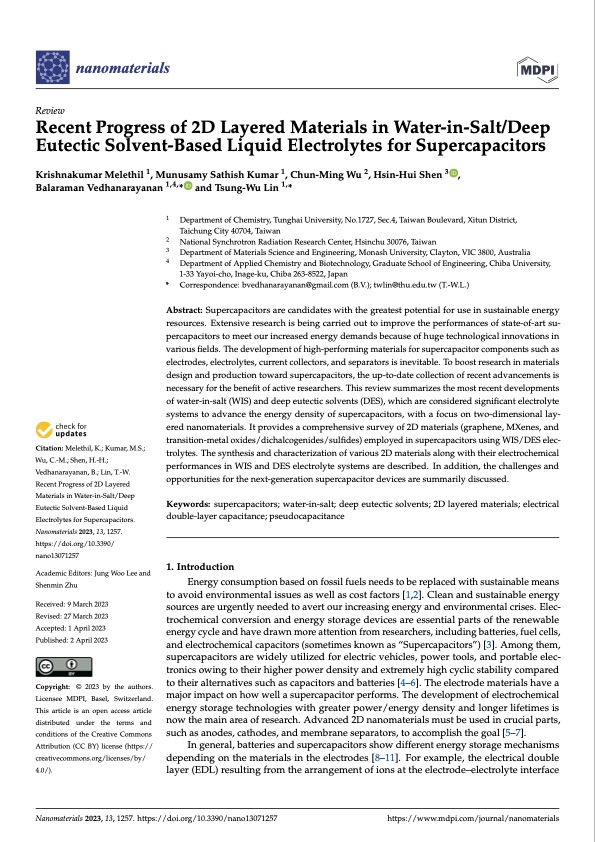
PDF Publication Title:
Text from PDF Page: 001
nanomaterials Review Recent Progress of 2D Layered Materials in Water-in-Salt/Deep Eutectic Solvent-Based Liquid Electrolytes for Supercapacitors Krishnakumar Melethil 1, Munusamy Sathish Kumar 1, Chun-Ming Wu 2, Hsin-Hui Shen 3 , Balaraman Vedhanarayanan 1,4,* and Tsung-Wu Lin 1,* 1 2 3 4 * Correspondence: bvedhanarayanan@gmail.com (B.V.); twlin@thu.edu.tw (T.-W.L.) Abstract: Supercapacitors are candidates with the greatest potential for use in sustainable energy resources. Extensive research is being carried out to improve the performances of state-of-art su- percapacitors to meet our increased energy demands because of huge technological innovations in various fields. The development of high-performing materials for supercapacitor components such as electrodes, electrolytes, current collectors, and separators is inevitable. To boost research in materials design and production toward supercapacitors, the up-to-date collection of recent advancements is necessary for the benefit of active researchers. This review summarizes the most recent developments of water-in-salt (WIS) and deep eutectic solvents (DES), which are considered significant electrolyte systems to advance the energy density of supercapacitors, with a focus on two-dimensional lay- ered nanomaterials. It provides a comprehensive survey of 2D materials (graphene, MXenes, and transition-metal oxides/dichalcogenides/sulfides) employed in supercapacitors using WIS/DES elec- trolytes. The synthesis and characterization of various 2D materials along with their electrochemical performances in WIS and DES electrolyte systems are described. In addition, the challenges and opportunities for the next-generation supercapacitor devices are summarily discussed. Keywords: supercapacitors; water-in-salt; deep eutectic solvents; 2D layered materials; electrical double-layer capacitance; pseudocapacitance 1. Introduction Energy consumption based on fossil fuels needs to be replaced with sustainable means to avoid environmental issues as well as cost factors [1,2]. Clean and sustainable energy sources are urgently needed to avert our increasing energy and environmental crises. Elec- trochemical conversion and energy storage devices are essential parts of the renewable energy cycle and have drawn more attention from researchers, including batteries, fuel cells, and electrochemical capacitors (sometimes known as “Supercapacitors”) [3]. Among them, supercapacitors are widely utilized for electric vehicles, power tools, and portable elec- tronics owing to their higher power density and extremely high cyclic stability compared to their alternatives such as capacitors and batteries [4–6]. The electrode materials have a major impact on how well a supercapacitor performs. The development of electrochemical energy storage technologies with greater power/energy density and longer lifetimes is now the main area of research. Advanced 2D nanomaterials must be used in crucial parts, such as anodes, cathodes, and membrane separators, to accomplish the goal [5–7]. In general, batteries and supercapacitors show different energy storage mechanisms depending on the materials in the electrodes [8–11]. For example, the electrical double layer (EDL) resulting from the arrangement of ions at the electrode–electrolyte interface Department of Chemistry, Tunghai University, No.1727, Sec.4, Taiwan Boulevard, Xitun District, Taichung City 40704, Taiwan National Synchrotron Radiation Research Center, Hsinchu 30076, Taiwan Department of Materials Science and Engineering, Monash University, Clayton, VIC 3800, Australia Department of Applied Chemistry and Biotechnology, Graduate School of Engineering, Chiba University, 1-33 Yayoi-cho, Inage-ku, Chiba 263-8522, Japan Citation: Melethil, K.; Kumar, M.S.; Wu, C.-M.; Shen, H.-H.; Vedhanarayanan, B.; Lin, T.-W. Recent Progress of 2D Layered Materials in Water-in-Salt/Deep Eutectic Solvent-Based Liquid Electrolytes for Supercapacitors. Nanomaterials 2023, 13, 1257. https://doi.org/10.3390/ nano13071257 Academic Editors: Jung Woo Lee and Shenmin Zhu Received: 9 March 2023 Revised: 27 March 2023 Accepted: 1 April 2023 Published: 2 April 2023 Copyright: © 2023 by the authors. Licensee MDPI, Basel, Switzerland. This article is an open access article distributed under the terms and conditions of the Creative Commons Attribution (CC BY) license (https:// creativecommons.org/licenses/by/ 4.0/). Nanomaterials 2023, 13, 1257. https://doi.org/10.3390/nano13071257 https://www.mdpi.com/journal/nanomaterialsPDF Image | Water-in-Salt Eutectic Solvent-Based Liquid Electrolytes

PDF Search Title:
Water-in-Salt Eutectic Solvent-Based Liquid ElectrolytesOriginal File Name Searched:
nanomaterials-13-01257.pdfDIY PDF Search: Google It | Yahoo | Bing
Salgenx Redox Flow Battery Technology: Power up your energy storage game with Salgenx Salt Water Battery. With its advanced technology, the flow battery provides reliable, scalable, and sustainable energy storage for utility-scale projects. Upgrade to a Salgenx flow battery today and take control of your energy future.
| CONTACT TEL: 608-238-6001 Email: greg@infinityturbine.com | RSS | AMP |